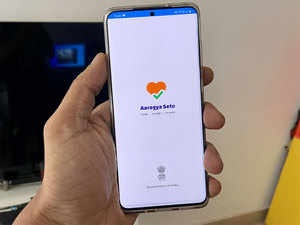
The data generated by the app’s users would play a role in aiding the government make policy interventions: specifically, managing the eventual removal of the ongoing lockdown.

COVID-19 CASES
WorldIndiaConfirmed6,412Deaths199Confirmed1,595,350Deaths95,455BENGALURU: On Monday, while addressing workers of the Bharatiya Janata Party (BJP) on its 40th anniversary, prime minister Narendra Modi had a few requests for them. One of them involved an app — Aarogya Setu — launched last week by the Government of India.
“You must be able to persuade at least 40 people to install this Aarogya Setu app and tell them about this,” he said. It was probably the most significant endorsement of the app, whose download link had been making the rounds on most WhatsApp groups linked to the BJP IT Cell even earlier. In a way, this was a throwback to how the government pushed its unified payment interface-based product — BHIM, post the 2016 demonstration exercise.
But even before the PM spoke on Monday, sources told ET, an aggressive, government-led adoption drive was underway, with the ministry of electronics and information technology (Meity) activating several service providers known for their extensive distribution network: banks, telecom companies, in some cases, schools and colleges. The nudge was largely citizen-focused, given the app’s value in informing citizens and alerting them about their proximity to COVID-19 infected persons or people who may have come in contact with them.
But what these circulars did not say, was that the data generated by the app’s users (in aggregated, anonymized form) would play a role in aiding the government make policy interventions: specifically, managing the eventual removal of the ongoing lockdown. A cursory reading of the app’s privacy policy says that the data would be used by the Government of India “in anonymised, aggregated datasets for the purpose of generating reports, heat maps, and other statistical visualisations for the purpose of the management of COVID-19 in the country.”
For that, it needs users. Millions of them — a good chunk of India’s smartphone user base, which currently stands at 500 million, according to industry reports. “We are yet not at a stage where you can do universal adoption,” says a person who was involved in consultations for Aarogya Setu, on a condition of anonymity. As of 8 April, Aarogya Setu has over 10 million downloads on the Google Play Store, while it is also the top-tank app on Apple’s AppStore in the ‘Health and Fitness’ category. Sources also told ET that the app could also have feature phones versions, with the Indian Institute of Technology Madras working on IVRS-based features, with testing reaching “maturity levels.”
Which is also why a day after its formal launch, the government set up a committee, to develop and implement a “Citizen app technology platform” over the next three months, with corporate titans such as Tata Sons chairman N Chandrasekharan, Mahindra & Mahindra chairman Anand Mahindra, and other senior bureaucrats and experts. This “citizen app technology platform” could eventually involve the Aarogya Setu, according to Meity officials.
The committee met over video conference last week for an “introductory meeting”, with several inputs coming forward. One input involved using the platform to issue and manage ePasses for gig economy workers, something already underway in cities like Bengaluru, New Delhi and Hyderabad.
But a key suggestion, from one of the committee members, said that with several products already in place across central and state governments, the platform must “integrate all data”, to first, understand how the disease was spreading. And, for the app (or a platform) to be effective and detect or alert any positive COVID-19 cases or their contacts, people would have to start moving, which could only happen after the easing of the lockdown.
“We have to look at the data coming in from all the states and understand the way the disease is spreading. This could help that, and basis the data, help us with predictive modelling,” says a committee member on a condition of strict anonymity. “The app is for the benefit of the citizens, especially once the government would remove the lockdown, even in a staggered way. The platform would also help the government in making key policy interventions,” the member added.
This, sources said, could involve dividing India into three zones based on the data — red, yellow and green — to implement easing lockdown conditions. “The idea is to devolve decision making, and the data could help state governments (since health is a state subject) and municipalities make decisions better, beyond lockdowns in events like community testing,” says the first person quoted in the story.
Equally, there is an urgency around the need to build this platform out. What was proposed for three months, has to be done in three weeks, else it won’t work out, according to the member of the committee quoted earlier. “Everyone (states) is working hard, with their own models. There is a competitive feeling among the states, and that is actually helping us, and by the looks of it, every state is learning from each other at this stage,” the member adds.
Source: indiatimes.com

